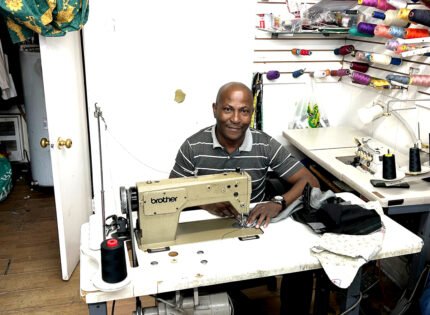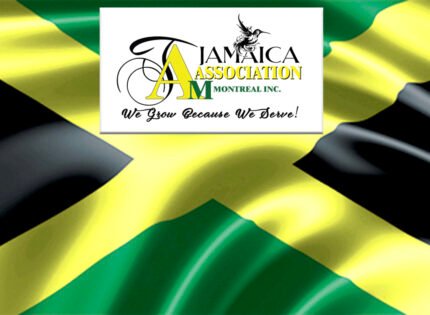by Rasta KEITH
It’s carnival time again. And on July 7, tens of thousands of Montrealers and their neighbors, friends and visitors from all over the world will converge on this city, which is so well identified by its seductive logo of those thick, red female lips, to revel in calypso and soca music as they dance and “chip” in the hot sun down the road. And as everyone already knows, there could be no real Caribbean-style street revelry without a good dose or overdose of rhythmic calypso or, for that matter, soca music.
Sad to say, though, if one were to judge from the support, or lack thereof, for a soca/calypso show which was staged by one of the city’s most tenacious promoters, Master Neville (Nato) Brown, at the easily accessible cultural complex at 6767 Cote des Neiges Road on Sunday June 3 as a launch pad for kicking off the carnival season, then the prognosis for the future of the spectacle in this city might be determined, at best, as being on urgent life support.
Everything seemed to have been in place for a bumper evening of fun and frolic. With one of the finest line-up of local performers, including the likes of Doggies, Skippy, Loveman-Kent, Pufty, and the indomitable Mello-G, backed-up by the musical versality of the local band, Jab Jab, expectations for a memorable evening could not have been greater. And when one adds to this the fine culinary skills of Marilyn Fisher, a well-stocked bar, and the day’s fine weather, the poor turn out of patrons at the show must boggle the mind.
Even so, despite the fact that just about one-fifth of the seating capacity of the hall was filled, it is safe to say that no one who had taken the time off to put their money where their mouth is, in terms of their support for Caribbean culture, had departed from the venue feeling that it might have been better for them to burn the $20 admission fee. On the contrary, it was clearly obvious that everyone who was there that evening had an enjoyable time. And so, the question as to why so few people seem to really care about the health of Caribbean culture in this city should be of concern to everyone who still seems to relish in the fun and frolic called Carnival.
The grapevine has it that the problem has nothing to do with a diminishing love for the culture. Persons holding this viewpoint to the mammoth crowds that gather downtown to take in the parade of the bands at carnival time. They also cite such events as Trini Day and Jamaica Day which draw thousands to Jean Drapeau Park every year. Still, while such observations might truly be on point, it might be contended that the only factor contributing to the huge success of such events is that Black people always show up in droves for any event so long as it’s free.
Not so long ago, when Noel Alexander attempted to collect a meagre $5 admission fee to the grounds at the old Blue Bonnets race track for Jamaica Day, the crowds had in fact shown up. But most of them refused to pay the miniscule amount and chose instead to enjoy the show from outside the fence.
Thanks to the government and other sponsors, however, Jamaica Day and other similar functions are still very much alive. Accordingly, even if promoters were to attempt to charge an admission fee of as little as a loonie for such kinds of live shows, most Black people might still find some kind of excuse as to why they really can’t afford to pay.
Of course, this kind of brash talk might not go down too well with many in the Black community. But the evidence seems to be too overwhelming to be swept under the rug.
For example, just before his death of a heart attack in Germany, Joseph Hill of the reggae group Culture held a concert at the now defunct Rainbow Restaurant. At a price of just $25 one might have expected the event to be sold out. As it turned out, the show was in fact sold out, but only because some 80% of those skanking fans were white folks.
Another case in point was the “Father vs. Son Duel” staged by Gemma Raeburn at the Oscar Peterson Concert Hall. And what an evening it was. Granted that it was something different in that it was essentially a piano recital. Even so, the show was saved from turning out to be a flop only because of the huge number of white folks in attendance.
Now, if Black people would not pay to see such world-class acts, one could only imagine what it’s like for the local guys. And so, despite the common notion that Black people instinctively love music, it might be better said that Black people readily gravitate and react to rhythmic sounds, especially when it’s free.
The other side of this ugly fiasco is that many in the community have been pointing fingers directly at the promoters themselves. The usual gripe is that most of the promoters and organizers are a bit shady. And, as might be expected, the allegation most frequently proffered in support of that view is that many showbiz entrepreneurs often come up woefully short in compensating the artistes who perform for them.
But while there might be some truth to this assertion, it might be argued that the real root of the problem lies elsewhere. For if the receipts at the gate fall short of expectations, as is often the case, it is difficult to see how a promoter might be able to honour his obligations without having to dip his hands in his own pockets, as Nato says he is often forced to do.
In other words, the state of Caribbean culture and, by extension, Black culture in Montreal and other North American cities, seems to be caught up in a paradoxically vicious circle. Without the patrons supporting the events in meaningful numbers, the organizers would be unable to meet their financial commitments. And if the artistes find themselves always having to perform without having anything to show for it, the only logical outcome would be that most of them would be forced to pack up their “old kit-bag”, leaving their talents to atrophy.
To paraphrase the popular biblical verse: “Man shall not live by bread alone.” And so, it might be equally said that promoters and artistes cannot live by love of their art alone. For, no matter how much an artiste might enjoy being on a stage and entertaining his or her fans, or how much satisfaction a particular promoter might derive from seeing crowds of happy spectators returning home after a function, he cannot fill a shopping cart at a grocery store or at a pharmacy and simply tell the cashier that he is unable to pay because he has not been able to earn anything from his craft.
The interesting thing about this matter is that few of the naysayers might have ever been in the driver’s seat either as a promoter or as an artiste. Putting on a three-hour show might seem like a cake-walk to those who have never ventured to do so. But after factoring in all of the ups and downs required for pulling off a successful event, the returns for the promoter seldom surpasses the hourly minimum wage. And the situation becomes even more dire in the case of performers who must spend weeks and months of practice before stepping foot on a stage.
Needless-to-say, the members of the Caribbean community should try to rise to the occasion and show a greater appreciation for local talent. For although it might seem as a typical chicken and egg situation, one could hardly help wondering whether a vibrant community gives rise to a vibrant culture or whether a vibrant culture gives rise to a vibrant community. Even so, it makes absolutely no sense moping over the disappearance of the culture of any segment of the broader society without making the necessary effort to sustain it.
Most of us are familiar with the phrase “gone too soon.” And although the particular saying is used more and more often these days with reference to the passing of our loved ones and acquaintances, it could be used with just as much pertinence in the case of vanishing traditions and cultures.
Not too long ago, a considerable number of the stores on Victoria Avenue in the district of Cote Des Neiges were black-owned. Today, the picture is very different with most of the businesses owned by folks of other nationalities, and with a completely different ethnic mix dominating the landscape. And the same could be said of other neighborhoods in Notre Dame de Grace (NDG), Little Burgundy, and elsewhere.
And people of African-Caribbean derivation have no one else but themselves to blame for their dwindling presence here in Montreal and other North American cities. As the saying goes: “Use it or loose it.”
And Black people seem to have a peculiar knack for loosing things rather than for holding on to things. For all intents and purposes, Black people had lost their freedom and an entire continent partly because of their own lack of foresight. And the demise of most black-owned enterprises could be readily attributed to Black people’s preference for shopping everywhere but at black businesses; just as their lack of any real political power could be accounted for by their penchant for moving out of their own neighbourhoods once they get the earliest opportunity to do so.
These days, with a little hindsight, everybody talks about how “nice” the party at the Belvedere Motels used to be during the early years of Montreal carnival. And every now and then, someone could be heard reminiscing about the “good old days” at “Soca Village” on Cote St. Luc Road. No one might have ever thought that those times would have come to an end. And yet they surely have!
Still, as the saying goes: “You never miss the water till the well runs dry.” And so, it might take the absence of live shows staged by local promoters and local artistes to awaken Black people from their slumber and realize the value of what they have already lost.













